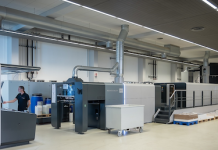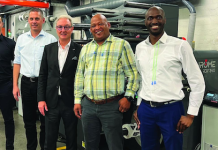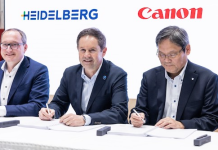Heidelberg has introduced the Linoprint CV which offers users more flexibility for the cost-effective printing of short and personalised runs and the Linoprint CP, the new digital printing system for volume-oriented users.
The Linoprint CV and Linoprint CP models are geared toward improved flexibility and productivity in the cost-effective production of short, personalised and hybrid print runs. The new Prinect Digital Front end sets a new standard in digital printing quality thanks to the use of Heidelberg Renderer (RIP) technology. Linoprint CV offers greater flexibility due to white and coating functions and supports a large range of materials with a printing speed of 90 pages per minute, high quality standards, and comprehensive functions.
The system will be able to print with five colours, making it unique in its segment. Besides the four primary colours, the system also offers white with high opacity or alternatively a coating with high gloss properties as an additional colour, either as a full-area or spot coating. Switching between white and a coating is simple, which means both surface finishing techniques can be used with flexibility.
Users can choose from a huge variety of substrates, ranging from structured papers to coated media, coloured paper and synthetic films. The multiple paper magazines in the system can be refilled on the fly, which keeps makeready times short. Several high-capacity magazines, which can be fitted with optional vacuum/suction-tape feeders also ensure a continuous supply of paper without the operator having to constantly monitor the Linoprint CV.
The system can also process long runs in a single pass, without interrupting production. A new, enlarged operating cockpit further enhances ease-of-use by helping the operator to both maintain a clear overview of every print job and re-run repeat jobs. Linoprint CP offers outstanding productivity and comprehensive inline finishing solutions and produces advertising and presentation materials at a printing speed of 130 pages per minute, as well as high-quality personalised print products, professionally bound books and brochures.
The system has a modular design that safeguards a high level of availability.
The image transfer and fusing units are physically separate, which reduces heat from affecting the process of image transfer and makes it easier to locate and clear paper jams. The standard configuration includes a vacuum/suction-tape feeder that ensures even difficult printing materials such as heavy coated media are fed into the press reliably.
The inline finishing units offer a whole host of solutions, from high-capacity stacking, perforating and folding all the way through to leaflets and books with adhesive binding. The Linoprint CP can also be used to process a range of materials, some of which can be quite challenging, such as structured papers and plastics. A colour toner with a low melting point further increases the range of materials that can be printed. The press operates using a feedback monitoring system that automatically corrects toner density and delivers excellent colour stability.





















